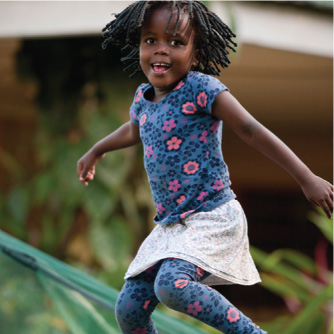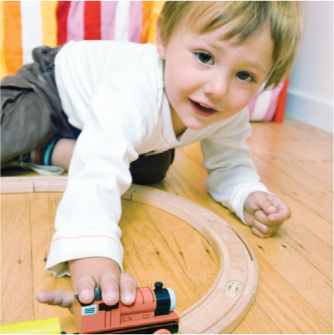Part IIIThe Developing Person So Far: Early Childhood
BIOSOCIAL

Body Changes Children continue to grow from ages 2 to 6, but at a slower rate. Normally, the BMI (body mass index) is lower at about ages 5 and 6 than at any other time of life. Children often eat too much unhealthy food and refuse to eat certain other foods altogether, insisting that food and other routines be “just right.”
Brain Development The proliferation of neural pathways and myelination continues. Parts of the brain (e.g., the corpus callosum, prefrontal cortex, amygdala, hippocampus, and hypothalamus) connect, which allows lateralization of the brain’s left and right hemispheres and better coordination of the left and right sides of the body; it also leads to a decline in impulsivity and perseveration.
Improving Motor Skills Maturation of the prefrontal cortex allows for impulse control; ongoing myelination of the corpus callosum and lateralization of the brain permit better physical coordination.
Injuries and Abuse Far more children worldwide die of avoidable accidents than of diseases. Child abuse and neglect require primary, secondary, and tertiary prevention.
COGNITIVE

Thinking During Early Childhood Piaget stressed the young child’s egocentric, illogical perspective, which prevents the child from grasping concepts such as conservation. Vygotsky stressed the cultural context, noting that children learn from mentors—
Language Learning Language develops rapidly. By age 6, the average child knows 10,000 words and demonstrates extensive grammatical knowledge. Young children can become balanced bilinguals during these years if their social context is encouraging.
Early-
PSYCHOSOCIAL

Emotional Development Self-
Play All young children play, and they play best with peers. Play helps children develop physically and teaches emotional regulation, empathy, and cultural understanding.
Challenges for Caregivers A caregiving style that is warm and encouraging, with good communication as well as high expectations (called authoritative), is most effective in promoting the child’s self-
Moral Development Morality becomes more evident during early childhood. Empathy produces prosocial behavior; antipathy leads to antisocial actions. Aggression takes many forms; bullying aggression is ominous. Every method of parental discipline affects children’s emotional development.